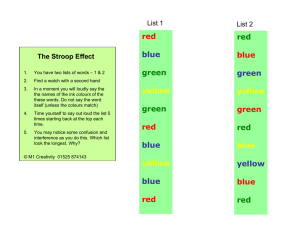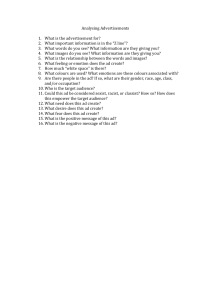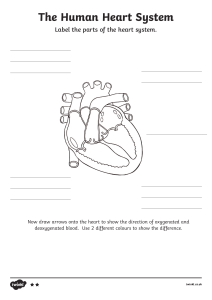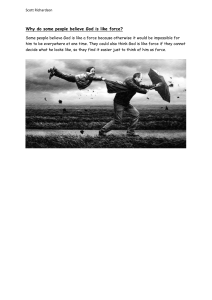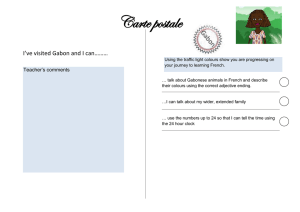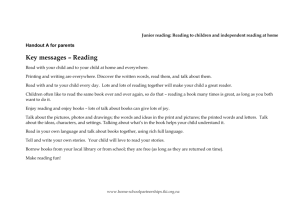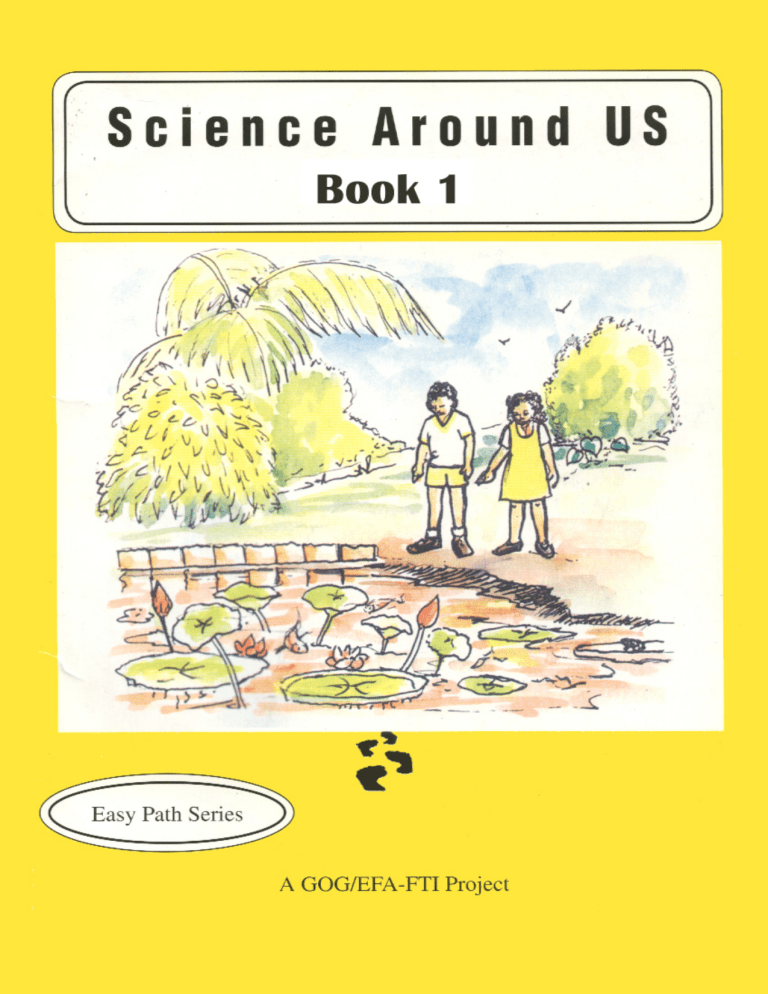
Acknowledgements The Ministry of Education wishes to acknowledge the work done by the following persons who were involved in the production of the first edition: Rookmin Bisnauth Jennifer Cumberbatch Elizabeth Mangar Dwarka Shivraj Pamala Wong Bibi Young Maylene Duncan Nadia Lockhart The work of the following persons who were involved in the production of the second edition is also acknowledged Sybil Blackman Melcita Bovell All rights reserved. No part of this publication may be reproduced, stored in a retrieval system or transmitted in any form or by any means without the prior permission of the copyright owner. Published by the Ministry of Education Georgetown, Guyana Printed by VonHoffmann Corporation Revised 2004 Revised 2013 i SCIENCE AROUND US BOOK 1 WRITING TEAM: Rookmin Bisnauth Jennifer Cumberbatch Elizabeth Mangar Dwarka Shivraj Pamela Wong Bibi Young SUBJECT SPECIALIST: Jennifer Cumberbatch ILLUSTRATOR: Maylene Duncan GRAPHICS PLACED BY: Nadia Lockhart DESIGN BY: Nadia Lockhart COVER DESIGN BY: Maylene Duncan NOT FOR SALE PRINTED FOR THE MINISTRY OF EDUCATION GOVERNMENT OF GUYANA A COG/EFA-FTI Project Easy Path Series ii FOREWORD One welcomes the publication of this series of textbooks as part of the Primary Education Improvement Project funded by the Inter-American Development Bank and the Government of Guyana. This series of texts has been long in planning, writing and producing. In the process however, many Guyanese have developed skills in textbook writing and publication. This will serve Education well in the future. We congratulate all those responsible for the production of these texts. They have done a good job. Guyanese children at the Primary level, and, indeed, the society as a whole, will be the beneficiaries of their labour. Thanks to the Inter-American Development Bank for its financial support. Primary Education in Guyana will benefit considerably with the availability of relevant reading material. Hon.A.Priya Manickchand Dale Bisnauth Minister of Education Senior Minister of Education and Cultural Development iii TABLE OF CONTENTS Chapter 1 Human Body ........................................................................... 1 Body parts are useful .......................................................................... 3 Caring for our body ............................................................................. 9 Chapter 2 Looking at Animals ............................................................... 11 Common animals in the environment ............................................... 12 Animals have many body parts too! ................................................. 15 Caring for our animals ....................................................................... 18 Chapter 3 Plants we know .................................................................... 20 From seed to plant ............................................................................ 22 Keeping plants alive .......................................................................... 24 Plant Parts ......................................................................................... 26 Plants are useful................................................................................ 27 Chapter 4 Weather ............................................................................... 29 Chapter 5 Sources and uses of water .................................................... 32 Using water wisely ............................................................................ 34 Term One Review .............................................................................. 35 Chapter 6 The Environment .................................................................. 39 Life Processes .................................................................................... 41 iv Chapter 7 Materials .............................................................................. 44 Colours we know ............................................................................... 49 Some shapes we know ...................................................................... 51 Term 2 Review .................................................................................. 52 Chapter 8 Earth and Space .................................................................... 54 Chapter 9 Energy .................................................................................. 55 Chapter 10 Force................................................................................... 59 All about forces ................................................................................. 60 Term Three Review ........................................................................... 63 v CHAPTER 1 HUMAN BODY Our body is made up of many parts. Some parts are found outside of our body. These parts are called external body parts. Not all body parts are found on the outside. Some are found on the inside of our bodies as well. Body parts that are found on the inside of our bodies are called internal body parts. Let’s learn the names of our EXTERNAL body parts. Take a look at the diagram on the next page to help you name the parts. Can you name these parts? 1 2 BODY PARTS ARE USEFUL Let us read this poem to find out the uses of some of our body parts. Eyes to see all things around, Ears to hear the smallest sound, Nose to smell and tongue to taste, Sweets from shops on our streets. Our Nose We smell with our nose. Talk about the smell of these things. Fish soap food 3 curry Powder perfume banana Pleasant and unpleasant smells We like pleasant smells. We do not like unpleasant smells. Which of the smells above did you like? Place a tick [√] next to your choice. Fish soap rotting garbage pleasant unpleasant 4 perfume Moving smells How do smells move? Moving smells can warn us. 5 Tasting things around us There are many tastes. We taste with our tongues. Some foods taste sweet. Sweet cake Some foods taste sour tamarind green mango 6 Some foods taste bitter Corilla Some foods taste salty Cheese 7 Activity What can the parts of my body do? Look! I can do these. Complete the table: Body Part Name 8 Number CARING FOR OUR BODY We need to keep our body healthy. Some of the ways we can keep our body healthy are: Exercising Resting Eating healthily 9 Activities 1. Make a scrapbook about the external body parts and their uses. 2. Complete the paragraph below by using the appropriate words from the box below. Our body has _________ parts. Some of these external body parts are _________, ____________ and __________. To keep our body healthy and strong we must___________ a balanced diet, ___________ regularly and __________our environment clean. 3. Complete the table below by placing the words given in the box under the correct headings. See Taste Hear 10 Smell Touch CHAPTER 2 LOOKING AT ANIMALS Boys and girls do you know that we are not the only ones that live on planet earth! Many animals live on planet earth. Can you name the animals shown in the pictures below? Snake, caterpillar, dog, duck, otter, cat, fish, bird, horse 11 COMMON ANIMALS IN THE ENVIRONMENT Name the animals in the picture. Name some other animals. Animals live in different places. Some places where animals live are on land, in water, trees and in the soil. These places are called habitats. Let us read the story below to find out more about animals and their habitats. 12 : You look very different from me! I have lovely brown hair. What has happened to yours Mr. Eagle? : I do not need brown hair! I have feathers. My home is the beautiful rainforest. I am very pleased to meet you. My friends – frog, snake and jaguar enjoy living in the rainforest. We live in different homes such as water, nests, trees and soil. : Oh, you mean your habitat! : What is a habitat? : Habitat is another name for the place where you live. : I have learnt something new. Thank you. 13 Here are some places where animals live. Activity Write the name of each animal under the name of their correct habitat. cat, dog, snapper, cow, snake, worm, alligator, trout, frog, parrot, caterpillar, hassar, bird, iguana, lizards, patwa Land Water Tree Soil 14 Swamp ANIMALS HAVE MANY BODY PARTS TOO! Look at the animal below. Can you name the body parts? ear head eye tail body paw 15 Take a look at the fish and bird above. Are they different? Complete the table below by using a tick () Parts Bird Dog Beak Feather Hair Tail Eyes Head Feet 16 Fish Animals use their body parts for different things. Can you tell what the following body parts are used for? 17 CARING FOR OUR ANIMALS Animals need to be cared for too. Look at the pictures below. Can you tell which picture shows that the animal is cared for? Some ways in which we can care for our animals are by feeding them, taking them to the vet, bathing them and keeping their surroundings clean. Activity 1. Put an X on the animals that are uncommon to your environment. 2. Look at the habitat and illustrate the animal that lives in each. 3. Give two reasons why we should care for animals. 18 1 I IL___ 19 I CHAPTER 3 PLANTS WE KNOW Plants are all around us! They help to keep the air we breathe clean. Plants provide us with the food we need. Plants help to make our surroundings beautiful. Can you name the plants below? Do you know of other plants? Can you name two others? 20 Plants are everywhere. Some plants are found on land. Some plants are found in water. Some plants are found on things in the air. land water 21 air FROM SEED TO PLANT All plants grow. Children, do you know that seeds grow into plants? Take a look at the picture above. Can you see that the seed has grown into a plant? This is called germination. When a seed germinates the root grows down and the green shoot grows up. Seeds need water, light and air to grow and stay alive. We can also get new plants from other parts of a plant. Let us look at the parts of a plant that new plants can grow from. 22 Stem Leaf Root Talk to a friend or neighbor. Find out the names of some plants that grow by leaf, stem or root. 23 KEEPING PLANTS ALIVE What do plants need to remain alive? Plants also need air. Find out more about this. 1. Place a plant in a plastic bag. 2. Tie the mouth of the bag. 24 3. Look at it each day. What do you notice? 25 PLANT PARTS leaf stem root flower fruit Plants have different parts. Look at the diagram below. Name the parts. Activity Now let us take a look at the diagram below. Label the plant parts. 26 PLANTS ARE USEFUL Do you know that plants are important to us? Let us look at the plants below. Mangrove Greenheart Pawpaw Can you say how these plants are useful to us? Mangroves protect Guyana’s coastline from the sea. The greenheart tree provides us with wood for buildings. 27 Papaw is a fruit that we eat. Plants are used for food. Plants are used for protection. Some plants are used for decoration. Some plants are used for medicine. Plants are used to provide wood for buildings such as houses. Activity Rearrange these letters to form words that tell what plants are used for. 1. 2. 3. 4. dofo ____________________________ soueh ____________________________ denimice ____________________________ tadroecion ___________________________ 28 CHAPTER 4 WEATHER In this chapter we will find out about weather. Study the pictures below. Can you identify the different types of weather? sunny rainy windy cloudy 29 Weather tells us about the different conditions of the air at the places where we live. These conditions last for a short time. The weather can be sunny, rainy, windy or cloudy. Let’s read the weather for each day. Sunday Monday Tuesday Wednesday Thursday Let’s have some fun reading this poem. WHAT’S THE COLOUR? Skies are blue when there is sun And grey when it rains When it’s cloudy I’m not so sure But windy! I know much more. 30 Friday Saturday Activity Fill in the missing letters for the different weather conditions 31 CHAPTER 5 SOURCES AND USES OF WATER Water is important for life. We can get water from: the tap the rain the lake the river 32 We use water everyday. Some things we use water for are: cooking watering plants washing dishes bathing Water song Water, water everywhere, everywhere, everywhere, Water, water everywhere, everywhere, everywhere, Water here and there Water is life, it keeps us alive Water, water everywhere, everywhere, everywhere, Water, water everywhere, everywhere, everywhere, (sung to the tune of Mary had a little lamb) 33 USING WATER WISELY Only a small amount of the earth’s water is available for drinking, washing, bathing, cleaning and cooking. We must therefore use water wisely. Look at the pictures shown in the chart. Can you identify ways in which we can save water? Use a bucket when washing the car Turn off the tap after use Collect rain water 34 TERM ONE REVIEW 1. Draw a line to connect the body part to its name. 2. (a) Name the body parts. (b) Say what they are used for. 35 Match the body parts with their functions Part of the body Use Mouth hearing Eye eating, speaking Fingers seeing Ear holding 36 3. Which of the following plants will soon die? A B C 4. Connect each animal to its home 37 5. Match the weather symbols with the weather conditions Sunny Windy Rainy Cloudy 38 CHAPTER 6 THE ENVIRONMENT Our environment is the place in which we live. Study the pictures below. Can you name some things found in each environment above? Types of environment Things found in the environment Our home and surroundings Our school and surroundings Our community Water area around us 39 We use the things found in our environment to help us to provide food we eat and work for us to survive. Different environments provide different types of food and work. Some plants and animals are also different in each environment. What are some foods found in your environment? What work do people do in your environment? Tell your teacher. 40 LIFE PROCESSES Some things around us are alive. Name the living things in the pictures below. Living things are of two groups. These groups are plants and animals. living things plants animals 41 The ……………………………………… in the picture is a living thing. It eats food, grows and moves. All living things breathe in air and reproduce one of its own kind. Living things also give off waste. Can you name the activity done by each living thing as shown in the pictures below? Some living things are very small and cannot be seen with the eyes 42 Activities 1. Can non-living things move? [] Yes [] No 2. Match the words in the box below with what the pictures show. feeding, moving, breathing 43 CHAPTER 7 MATERIALS Things around us are made up of one or more types of materials. These materials are found in our environment. Different materials are found in different types of environments. For example, at home we have different things from the ones at school. Things at home Things at school Can you name the things in the picture above? Some common materials are: Wood Cloth Plastic Glass 44 Rubber Metal The picture below shows an environment. Do you remember that we learnt a lot about environment in chapter 5? Now let us look at this picture. Can you identify some common materials from this picture? 45 Boys and girls, where do you think these things in our environment come from? Activities Complete the table below by indicating the materials from which the items are made. Items Made from Tins Chair Paper Cloth Sponge Wire Slippers 46 The materials in our environment are of two types: living and non-living. Some of these materials were once alive. Group the list of materials below into those that can be seen and those that can be touched. colours, wood, plastic, cloth, light Can be seen Can be touched Materials in our environment are used for many purposes. Would you like to tell a friend what are some of these uses? 47 Complete the table below. Name of materials Uses Wood Furniture, ornaments, ……………… Plastic Basins, bucket, …………………… Leather Metal Paper Cloth Sponge 48 bags, Here’s a riddle for you to solve. I come in different colours. People wear me on their bodies when it rains. I am made of plastic. What am I? COLOURS WE KNOW Let’s read this poem Colours! Colours! Colours! Colours everywhere Umbrellas have many colours and so do shoes Some are red, pink and even yellow too While trees are green and the blue sky clean Look around, colours could be seen. What colours does this poem talk about? Can you find these colours below? a red rose a blue car 49 a yellow banana Some other colours Name an object and its colour found near to you. Activity Draw these pictures and colour them. 50 SOME SHAPES WE KNOW Things around us have different shapes. Look at the shapes below. Let us name them. Circle Triangle Rectangle Square Cone Activities 1. Match these shapes with their names. Shape Name cone triangle cylinder 51 Cylinder 2. Can you name the shapes in the picture below? TERM 2 REVIEW 1. Draw two non-living things. 2. Look at pictures below. (a) Which cannot move from place to place by itself? (b)Which moves by flying? 52 3. Which of these moves but is a non-living thing? A B C 4. How many squares do you see in the diagram below? 5. Which of the following is made from metal? A B 53 C CHAPTER 8 EARTH AND SPACE Have you ever looked at the day or night sky carefully? Let us do so by looking at the two pictures below. Picture of the day sky Picture of the night sky Day is followed by night. During the day the sky appears light blue. During the day the sun is seen. At night the sky appears dark blue. The moon and stars can be seen at night. Sometimes clouds can be seen during the day and at night. Activities 1. Make your own drawing of the picture of the night and the day skies. Now compare these drawings. 2. Can you name some of the activities that occur during the day and at night? 54 CHAPTER 9 ENERGY Things we can do Some things that we do are eating, playing, dancing and sweeping. These actions cause us to use energy. Can you name other actions that we do? Where do we get energy from? The sun supplies us with all the energy we need. Did you know that energy is stored in the foods we eat? Plants make food using energy from the sun. When we eat our food our body gets energy to do work. We need energy every day to survive. 55 Some foods we should eat to get energy are shown in the pictures below. Can you name them? 56 Forms of Energy The sun gives us light and heat. These are forms of energy. When you go out in the sun what do you feel? sun Light Heat Can you name the items from the pictures below that provide us with light and heat? The bulb, candle and the torch give us light and heat energy. 57 Activity Complete the table below by placing a tick () in to indicate what type of energy is produced by the listed items Item Lit candle Sun Electric kettle Light Heat 58 Bell CHAPTER 10 FORCE The pictures below show things being moved. Can you identify the ways in which these things are moved? Some things need a push or a pull for it to move. A push is movement away from you and a pull is movement towards you. Some other actions that cause things to move are a twist, a turn and a lift. 59 ALL ABOUT FORCES Look at how these things move. Forces are used to move them. Where do the forces come from? wind muscle fuel water 60 Activities 1. Match the types of forces used in the table below with the correct pictures. Picture Force pull twist lift Turn Push 61 2. Fill in the missing letters in the boxes below to name the types of forces. No letters must be written in the blue boxes. L T P F W S S T P T N T H N L 62 G I G G I G I G TERM THREE REVIEW 1. Which of the pictures below shows the night sky? 2. Place an X under the picture that shows a pull. 3. The sun provides us with ___________ and ______________. 4. From which appliance will we get heat energy? B A 63 'Science Around Us' is a series of six pupils' books \\ ith corresponding teachers· manual-.. This series help~ pupils to develop and apply as they explore and come lO and content skill-. understand their environment. Each pupi l"s book contain;. review can be proce~' u~ed exerci~cs which to evaluate pupi h · progress. f r,-----------------------,, ' 'Science Around Us Book 3' foc uses on • Animals • Plants • Matter • Forces • Space • Light ''------------------------// NOT FO R SALE PRINTED FOR THE MINISTRY OF EDUCATION GOVERNMENT OF GUYANA. ISR:-.J 976-819R-03-6 www.education .gov.gy


